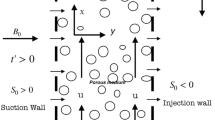Abstract
We present a formulation of the discontinuous Galerkin method aimed for simulations of gravity-driven viscous fingering instabilities occurring in porous media flow. Specifically, we are targeting applications characterized by complex geometrical features. Viscous fingering instabilities play a very important role in carbon sequestration in brine aquifers. The proposed method has the ability to preserve high order of accuracy on completely unstructured meshes, a feature that makes it ideal for high-fidelity computations of the challenging fingering flow patterns and very complex geometries of actual reservoirs and aquifers. An extensive set of numerical computations is also included, to confirm the stability, accuracy, and robustness of the method.
Similar content being viewed by others
References
Arnold, D.N., Brezzi, F., Cockburn, B., Marini, L.D.: Unified analysis of discontinuous Galerkin methods for elliptic problems. SIAM J. Numer. Anal. 39, 1749–1779 (2002)
Brezzi, F., Marini, L.D., Süli, E.: Discontinuous Galerkin methods for first-order hyperbolic problems. Math. Models Methods Appl. Sci. 14, 1893–1903 (2004)
Cockburn, B., Shu, C.W.: The local discontinuous Galerkin method for time-dependent convection-diffusion systems. SIAM J. Numer. Anal. 35, 2440–2463 (1998)
Ennis-King, J.P., Preston, I., Paterson, L.: Onset of convection in anisotropic porous media subject to a rapid change in boundary conditions. Soc. Pet. Eng. J. 17, 349–356 (2005)
Girault, V., Sun, S., Wheeler, M.F., Yotov, I.: Coupling discontinuous Galerkin and mixed finite element discretizations using mortar finite elements. SIAM J. Numer. Anal. 46, 949–979 (2008)
Gounot, J., Caltagirone, J.P.: Stabilité et convection naturelle au sein d’une couche poreuse non homogène. Int. J. Heat Mass Transfer 32, 1131–1140 (1989)
Hesthaven, J.S., Warburton, T.: Nodal Discontinuous Galerkin Methods Algorithms, Analysis, and Applications. Springer, New York (2008)
Hidalgo, J.J., Carrera, J.: Effect of dispersion on the onset of convection during CO2 sequestration. J. Fluid Mech. 640, 441–452 (2009)
Hidalgo, J.J., Carrera, J., Medina, A.: Role of salt sources in density-dependent flow. Water Resour. Res. 45, W05503 (2009)
Hoteit, H., Firoozabadi, A.: Multicomponent fluid flow by discontinuous Galerkin and mixed methods in unfractured and fractured media. Adv. Water Resour. 41, W11412 (2005)
Jr., J.D., Dupont, T.: Interior penalty procedures for elliptic and parabolic Galerkin methods. In: Lecture Notes in Physics, vol. 58. Springer, Berlin (1976)
Liu, R., Wheeler, M., Dawson, C., Dean, R.: Modeling of convection-dominated thermoporomechanics problems using incomplete interior penalty Galerkin method. Comput. Methods Appl. Mech. Eng. 198, 912–919 (2009)
Liu, R., Wheeler, M., Dawson, C., Dean, R.: On a coupled discontinuous/continuous Galerkin framework and an adaptive penalty scheme for poroelasticity problems. Comput. Methods Appl. Mech. Eng. 198, 3499–3510 (2009)
Pau, G.S.H., Bell, J.B., Pruess, K., Almgren, A.S., Lijewski, M.J., Zhang, K., Yang, C., Gu, Y.: High-resolution simulation and characterization of density-driven flow in CO2 storage in saline aquifers. Adv. Water Resour. 33, 443–455 (2010)
Phillips, P.J., Wheeler, M.F.: A coupling of mixed and discontinuous Galerkin finite-element methods for poroelasticity. Comput. Geosci. 12, 417–435 (2008)
Riaz, A., Hesse, M., Tchelepi, H.A., Orr, F.M.: Onset of convection in a gravitationally unstable diffusive boundary layer in porous media. J. Fluid Mech. 548, 87–111 (2006)
Rivière, B., Wheeler, M.F.: Discontinuous Galerkin methods for flow and transport problems in porous media. Commun. Numer. Methods Eng. 18, 63–68 (2002)
Rivière, B., Wheeler, M.F., Banas, K.: Part II. Discontinuous Galerkin method applied to a single phase flow in porous media. Comput. Geosci. 4, 337–349 (2000)
Rivière, B., Wheeler, M.F., Girault, V.: Elliptic collocation-finite element method with interior penalties. SIAM J. Numer. Anal. 15, 152–161 (1978)
Rivière, B., Wheeler, M.F., Girault, V.: Improved energy estimates for interior penalty, constrained and discontinuous Galerkin methods for elliptic problems. Part I. Comput. Geosci. 3, 337–360 (1999)
Rivière, B., Wheeler, M.F., Girault, V.: A priori error estimates for finite element methods based on discontinuous approximation spaces for elliptic problems. SIAM J. Numer. Anal. 39, 902–931 (2001)
Scovazzi, G., Gerstenberger, A., Collis, S.: A discontinuous Galerkin method for gravity-driven viscous fingering instabilities in porous media. J. Comput. Phys. (2011). doi:10.1016/j.jcp.2012.09.003
Siefert, C., Tuminaro, R., Gerstenberger, A., Scovazzi, G., Collis, S.S.: Algebraic multigrid techniques for discontinuous Galerkin methods with varying polynomial order. Comput. Geosci. (2012, submitted)
Sun, S., Wheeler, M.F.: Anisotropic and dynamic mesh adaptation for discontinuous Galerkin methods applied to reactive transport. Comput. Methods Appl. Mech. Eng. 195, 3382–3405 (2006)
Sun, S., Wheeler, M.F.: Local problem-based a posteriori error estimators for discontinuous Galerkin approximations of reactive transport. Comput. Math. Appl. 52, 637–650 (2006)
Sun, S., Wheeler, M.F.: Discontinuous Galerkin methods for simulating bioreactive transport of viruses in porous media. Adv. Water Resour. 30, 1696–1710 (2007)
Sun, S., Wheeler, M.F.: Local problem-based a posteriori error estimators for discontinuous Galerkin approximations of reactive transport. Comput. Geosci. 11, 87–101 (2007)
Sun, S.Y., Wheeler, M.F.: Symmetric and nonsymmetric discontinuous Galerkin methods for reactive transport in porous media. SIAM J. Numer. Anal. 43, 195–219 (2005)
Sun, S.Y., Wheeler, M.F.: A posteriori error estimation and dynamic adaptivity for symmetric discontinuous Galerkin approximations of reactive transport problems. Comput. Methods Appl. Mech. Eng. 195, 632–652 (2006)
Xu, X., Chen, S., Zhang, D.: Convective stability analysis of the long-term storage of carbon dioxide in deep saline aquifers. Adv. Water Resour. 29, 397–407 (2006)
Author information
Authors and Affiliations
Corresponding author
Additional information
Sandia National Laboratories is a multiprogram laboratory managed and operated by Sandia Corporation, a wholly owned subsidiary of Lockheed Martin company, for the U.S. Department of Energy’s National Nuclear Security Administration under contract DE-AC04-94AL85000.
Rights and permissions
About this article
Cite this article
Gerstenberger, A., Scovazzi, G. & Collis, S.S. Computing gravity-driven viscous fingering in complex subsurface geometries: A high-order discontinuous Galerkin approach. Comput Geosci 17, 351–372 (2013). https://doi.org/10.1007/s10596-012-9334-y
Received:
Accepted:
Published:
Issue Date:
DOI: https://doi.org/10.1007/s10596-012-9334-y




